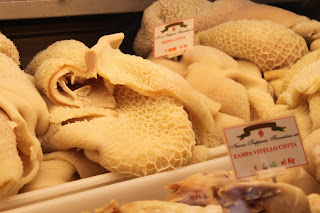 It’s a bustling morning in the old city center of Florence, Italy. The leather market vendors are uncrating their rolling shops and setting up the colorful display of rainbow dyed cow skin in the forms of purses, briefcases, belts, key chains, bracelets, shoes and jackets. A sprinkling of screen-printed “Ciao-Bella, Firenze” t-shirts assuming the Coca-Cola logo, cheap imported jewelry, and brightly painted pottery in the beautiful Tuscan tradition round out the market offerings for the onslaught of tourists about to make their way through the narrow, crowded streets. Amongst the many visitors are both Florentines and Foodies making their way past the street vendors to the true heart of the city: Il mercato centrale.
It’s a bustling morning in the old city center of Florence, Italy. The leather market vendors are uncrating their rolling shops and setting up the colorful display of rainbow dyed cow skin in the forms of purses, briefcases, belts, key chains, bracelets, shoes and jackets. A sprinkling of screen-printed “Ciao-Bella, Firenze” t-shirts assuming the Coca-Cola logo, cheap imported jewelry, and brightly painted pottery in the beautiful Tuscan tradition round out the market offerings for the onslaught of tourists about to make their way through the narrow, crowded streets. Amongst the many visitors are both Florentines and Foodies making their way past the street vendors to the true heart of the city: Il mercato centrale.
To the frequenter of the market, this glorious mecca of meat, fruit, vegetables, cheese, and pasta is often a daily excursion; a normal trip to acquire the necessary ingredients for the day’s culinary creations. To the first-time visitor, however, this maiden voyage poses the risk of being an “offal” assault on ones conventional understanding of acceptable carnivorous ingestibles.1 Stall after stall displaying never-before-seen cow, lamb, pig, and chicken pieces behind perfectly cleaned glass and overseen by a merchant beckoning you closer with an abrupt, but inviting, “Prego” or “Ciao”. As you step in for a closer look at these overflowing, pale-white honeycomb pillows, you realize that you are staring at the insides of a cow. Trippa, or stomach lining, is not the only offense on the menu: calf brains, liver, pig’s feet, tongue, veal face, chickens with both heads and feet intact, walk-in fridges with hanging halves of animals, and cured prosections of pig strung overhead like mistletoe. A far cry from the nicely cleaned and packaged boneless, skinless chicken breasts sealed with a sticker of a cage-free crowing rooster that most Americans are accustomed to purchasing. This is clearly the moment when Dorothy realizes she is “not in Kansas anymore”.
As a fledgling Food Network fan on study-exchange in Florence in my early twenties, I was intrigued with Mercato centrale in all its horrific animal offerings and was strangely drawn to the stripped down presentation of meat. I was used to my 30-Minute-Meals and Everyday Italian dinners; this was not the Italian food I was expecting. Sure, I could still get a de-boned, skinless piece of chicken, but I watched as the butcher pulled it from a stack nestled between a pile of livers and lifeless chicken heads that seemed to stare up at me as if I were the one who had wrangled their neck. As my fascination grew, I found myself visiting the market nearly everyday, walking up and down the isles, admiring each stall for the daily gifts of the land being offered. I wondered, though, how was it that I was so enthused, when others were so put-off?
My introduction to bizarre foods (not quite on the same level as Andrew Zimmern) began as a child. I remember jars of pickled pigs feet and buckets of raw oysters in my family’s refrigerator. My siblings and I would crowd around as our father offered us bites of smoked oysters or liver and onions. My mother once braved a whole cow tongue, boiling it until the house was steamy with the stench, as a special surprise for Dad, which, of course, he enthusiastically encouraged us to try. Even today, orders for lingua burritos are on the bill when my family goes out to eat at a Mexican restaurant and my sister is well-known for her Menudo soup (although only half of the family will eat it).
It was clear that the roots of offal eating were always present in my life, but it was not until I discovered the Mercato centrale, that I began to understand the valuable role that head-to-tail consumption plays in a waste-conscious culture. Where tripe and other offal offerings were once considered throwaway scraps, these pieces are now making appearances on restaurant menus all over the world as delicacies. In the wake of the Slow Food movement, as well as an increasing awareness of local, green, organic, and humane food consumption, people are returning closer to the land, which means embracing the whole animal – tongue to testicles to tale. This means removing the sanitized packaging of our Supermarkets through which our culture has been trained to interact with its food, rolling up our sleeves, and getting our hands bloody; not in the horror movie sense, but in the real, honest, carnivorous sense of the word. After all, if one is going to eat meat, it is in one’s best interest to know where said meat is from, how it’s life ended, and how it was prepared, even if that means looking your chicken in the face before you remove its head and feet.
1For more information regarding offal see the following two references: Carey Polis, “Offal 101: A Guide To Whole Animal Eating,” on The Huffington Post, http://www.huffingtonpost.com/2011/08/18/offal-guide_n_927620.html#s330546&title=Blood (Accessed 08.21.11) and “What Is Offal?,” on Offal Good™, http://www.offalgood.com/what-is-offal (Accessed 08.21.11)
Related Resources:
• Brad Farmerie, “Blood Work,” on Food Arts,
• Trippa alla Fiorentina
Local San Francisco restaurants to try offal:
• Incanto Restaurant & Wine Bar, 1550 Church St
• Boccalone, 1 Ferry Bldg
• The Alembic, 1725 Haight St
• El Farolito, 2779 Mission St
No comments:
Post a Comment